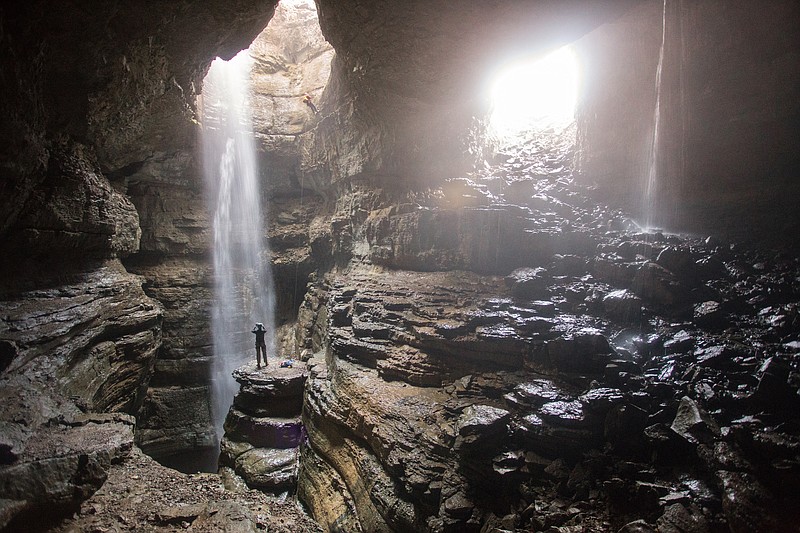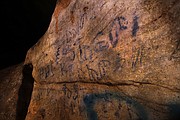Bats, Beer and Bluegrass at Frick’s Cave Preserve
To celebrate its 25th anniversary, Southeastern Caving Conservancy Inc. is hosting an evening concert at Frick’s Cave — the first event of its kind. Live bluegrass music will be presented by Barefoot Nellie & Co., food will be catered by 212 Market Restaurant and, at dusk, guests will have front-row seats when thousands of endangered gray bats flap from Frick’s Cave to hunt.Concert and dinner tickets are $50 per person. Concert-only tickets are $25 per person. All proceeds go to SCCi’s Stewardship Endowment fund, which is used to maintain cave preserves.When: Sept. 24, 5-9 p.m.Where: Frick’s Cave Preserve, Chickamauga, GeorgiaGet tickets: squareup.com/store/southeastern-cave-conservancy-inc
Balancing Conservation and Recreation
SCCi’s New Permit SystemCurrently, only some of SCCi’s preserves require visitors to obtain permits. Frick’s Cave, Stephens Gap and Snail Shell Cave are included in those. But beginning Jan. 1, 2017, all preserves managed by SCCi will require permits.The process is simple — and free: Prospective visitors will go to SCCi’s website, enter where and when they wish to visit, review preserve rules and sign a release. Then, the permit will be automatically emailed.The new permitting system will help SCCi balance recreation and conversation by helping to prevent caves from becoming “over-loved,” Knott says. “We can look at the numbers and say, ‘OK, if 50 [visitors] a day caused damage to cave fauna or flora, then let’s throttle that back [and] just allow 25 [visitors] a day.”
Noteworthy Numbers
10,000: number of endangered gray bats living in Frick’s Cave8: number of caves in the world in which 90 percent of gray bats are found170: number of caves managed by SCCi1,400: number of acres of land owned by SCCi16,475: total number of acres owned and/or leased by SCCi$2 million: value of owned land assets20: number of cavers who came together to form SCCi in 19911,000: number of SCCi members as of 2015$300,000: purchase price of most expensive cave acquisition$50,000: stewardship budget for 2016, which must cover preserve maintenance, signage, cleanups, environmental protection, taxes, insurance and more for all preserves managed by SCCi$2.5 million: SCCi’s five-year fundraising goal, the campaign for which kicks off on Sept. 24 with the Bats, Beer and Bluegrass event
There is a cave in Trenton, Georgia, alongside a two-lane highway. Its entrance appears beneath a limestone ledge - a shadowy gap through which people have crawled for thousands of years. Maybe more. In one of its many underground rooms, a Civil War signature dated 1858 is carved into the rock. In another room, mysterious Cherokee syllabary is scrawled.
Today, the cave, known as Howard's Waterfall, is one of the most visited caves in the region. In 1991, it was the first cave acquired by Southeastern Cave Conservancy Inc., a Chattanooga-based nonprofit organization founded that same year by cavers to protect access to caves. Twenty-five years later, SCCi owns or leases 170 caves - many of which host rare and threatened ecosystems - on 30 preserves in six states, making it the largest land conservancy dedicated to protecting caves in the country.
So why have you never heard of this organization?
"Caves are secret places," says Ray Knott, who was hired as SCCi's executive director last spring, making him the organization's first paid employee. As Knott explains, it is a caver's nature to protect these locations, and that mum's-the-word mentality was probably transferred to the organization, which historically has catered to cavers.
But now, Knott hopes to share the importance of these ancient places with non-cavers - like himself.
In addition to a background in nonprofit management and real estate, Knott says he brings to SCCi a bright-eyed enthusiasm for caves.
"The geography is fascinating," says Knott. He explains that to locate potential caves in Tennessee, one should look for sharp limestone outcroppings juxtaposed with a valley. But in areas like Kentucky, known for its rolling hills, caves are more likely to appear as subtle sinks in the landscape, a tip related to "ridge-walking" which he learned from SCCi director and chair of the stewardship committee Steve Davis. Ridge-walking is when cavers hike an area to scout for new caves.
However, SCCi measures success not in the number of caves it owns, but in the respective significance of each one of those caves, Knott says.
Howard's Waterfall, for instance, is considered culturally significant for its Cherokee and antebellum writings, though access to those vestiges had to be restricted after they were defaced. The cave itself, however, remains open to the public 365 days a year.
In contrast, Frick's Cave, located in Chickamauga, Georgia, and purchased by SCCi in 1997, is open to the public only one day a year. This is in order to protect its endangered gray bat population and its rare Tennessee cave salamander population, which make Frick's an important biological resource.
While Frick's Cave is, in essence, off limits, the 34-acre wooded preserve where it sits permits hikers and campers to visit year-round. But SCCi's most popular preserve for non-cavers is perhaps Stephens Gap in Alabama.
Encompassing 123 acres, Stephens Gap is famous, in part, for its accessibility. There are two entrances to the cave: a 144-foot vertical drop which requires rope skills, and a walk-in entrance located 30 feet away. Inside the cave, the effect of those two side-by-side chasms is otherworldly. Daylight streams into the abyss like shimmering rain.
"Stephens Gap is one of the most photographed caves in the world. So it is significant to us from that standpoint," says Knott.
Two other notable caves protected by SCCi include Snail Shell Cave, considered one of the most endangered karst communities in the U.S., and Neversink, a 162-foot-deep vertical cave beloved by skilled cavers for its recreational opportunities.
SCCi's list of preserves is long and ever-growing - as is the organization itself. In 25 years, SCCi has evolved to protect so much more than just cave access.
"I was having a conversation with [SCCi founding director] Kris Green a few months ago and I asked him what his proudest accomplishment has been," Knott says. "His answer was 'Protecting those bats at Frick's.' Here's this guy, a hardcore caver, who founded an organization buying caves for cavers, and his proudest accomplishment is one of true land conservancy."

